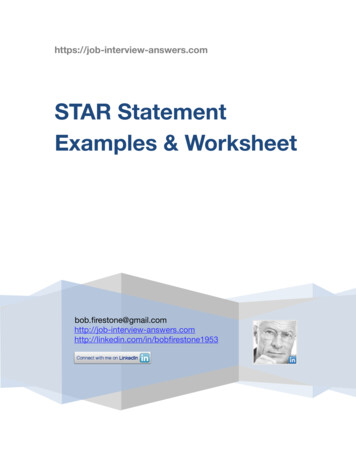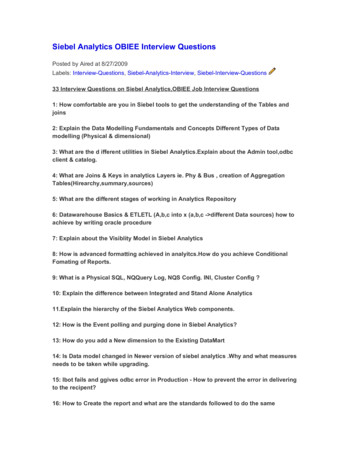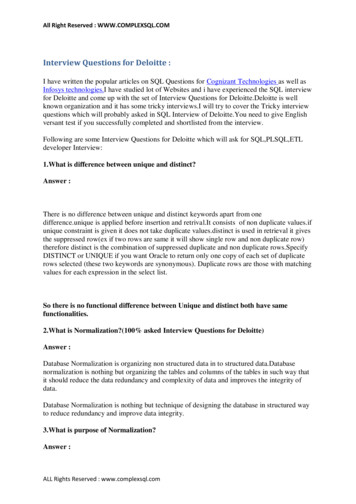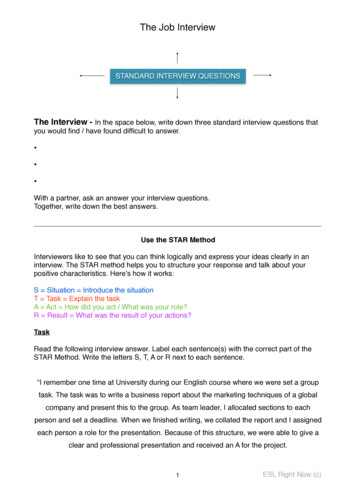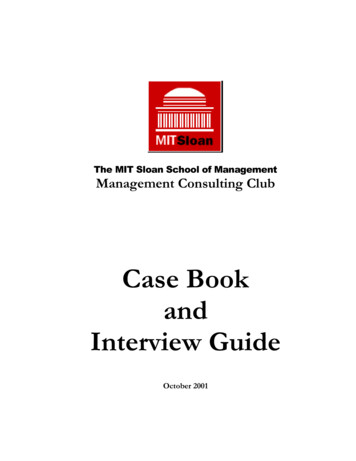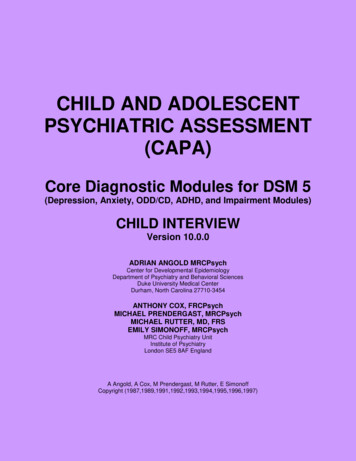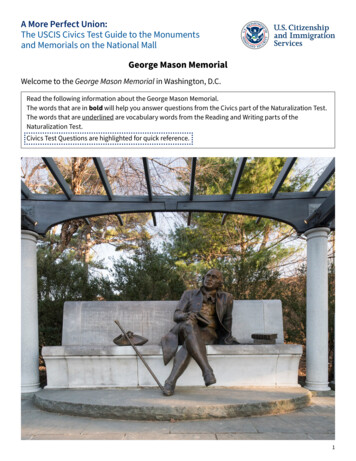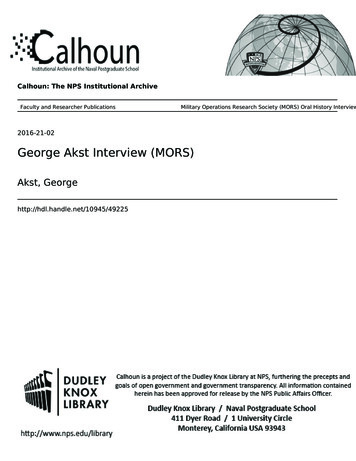
Transcription
Calhoun: The NPS Institutional ArchiveFaculty and Researcher PublicationsMilitary Operations Research Society (MORS) Oral History Interview2016-21-02George Akst Interview (MORS)Akst, Georgehttp://hdl.handle.net/10945/49225
INTRODUCTIONOral histories represent the recollectionsand opinions of the person interviewed,and not the official position of MORS.Omissions and errors in fact are corrected whenpossible, but every effort is made to present theinterviewee’s own words.Dr. George Akst has served as the SeniorAnalyst for the Marine Corps Combat Development Command (MCCDC), Quantico,Virginia, since 2004. Dr. Akst worked in theCenter for Naval Analyses (CNA) from1979 to 1998, and he has served as theMORS Marine Corps sponsor since 2005.The interview was conducted on August26, 2015, and August 31, 2015, in Quantico,Virginia.MORS ORAL HISTORYInterview with Dr. George Akst; Dr.Bob Sheldon, FS and Mr. Steve Stephens,Interviewers.Bob Sheldon: This is August 26, 2015,and we’re here for a MORS oral history interview with Dr. George Akst. Please tell usyour parents’ names.George Akst: My parents’ names wereTed and Estelle Akst.Bob Sheldon: Tell us about your parentsand how they influenced you.George Akst: Probably the strongest influence in my actual career was my father.He started teaching me mathematics—arithmetic—from an extremely young age,probably around three, so by the time I wasfour or five I was fairly adept at basic arithmetic, adding multiple digit numbers, maybesome multiplication. He used to get a kickout of running into friends in the street andsaying, ‘‘Hey George, how much is 15 times23?’’ Then I would spit out the answer, andeverybody was, ‘‘Wow, that’s pretty amazing!’’ That got me started in a career in mathematics, and I pretty much stuck to that fromthe time I was about three to the time I got outof the academia and into this field called operations research (OR).Bob Sheldon: What did your father do fora living?George Akst: He was an insurance adjuster for the bus company. He adjudicatedclaims back in the old days. This is not theway people do business today, but then,when somebody got injured on a New YorkCity public transit bus, he would try to settle the claim with them before it got intoa big deal and went to court. I would occasionally tag along with him on some of histrips. He would visit the injured partiesand talk to them about the situation. Hewould have money in his pocket, and hewould say, ‘‘How about 200? Would thatsettle the claim, and can we just sign offand say you are satisfied with this?’’ That’sthe way they did business. I think back onthat, and he was going into some prettysketchy neighborhoods in the South Bronxor Harlem with money in his pocket tryingto talk disgruntled people into settlinga claim about their injuries. I can’t imagineanybody really does that anymore; I don’tknow how they do that today. On the side,he was also an insurance broker.Bob Sheldon: Did he have a college degree himself?George Akst: Neither of my parentsgraduated from high school. And my sistersnever went beyond high school. I’m the firstcollege graduate in the family.Bob Sheldon: But your dad had somegood mathematical skills?George Akst: He was a pretty smart guy.I’ve always looked up to him as an intelligent person even though he didn’t havea lot of formal education. He droppedout in about the 11th grade. He grew upin the early part of the 20th Century andlived through the Depression. I guess hegot ‘‘street smarts’’ as opposed to a formaleducation.Bob Sheldon: Tells us where you went toelementary school, junior high, and highschool?George Akst: I went to the public schoolsin the Bronx from elementary school throughhigh school. I lived in the Bronx until I graduated from college, actually. There wereenough elementary schools in New YorkCity so that one was never very far fromyou. I went just three or four blocks awayfrom my house to P.S. 35 on 163rd St. in theBronx. My parents did not like the local junior high school in our South Bronx neighborhood, so we moved up to the mid-Bronxand I went to Creston Junior High School,which turned out to be an all-boys school.New York City had a number of specializedhigh schools—and still does—and you tookan exam for entrance into one of theseschools. I was accepted into the Bronx HighSchool of Science.Military Operations Research, V21 N2 2016, doi iety(MORS)Oral HistoryProjectInterview ofDr. GeorgeAkstDr. Bob Sheldon, FSGroup W, Inc.bs@group-w-inc.comMr. Cortez ‘‘Steve’’StephensRetired from the OperationsAnalysis Division of theMarine Corps CombatDevelopment Commandstephenscd@aol.comMILITARY OPSRESEARCH HERITAGEARTICLEPage 63
MORS ORAL HISTORY PROJECT . . . DR. GEORGE AKSTBob Sheldon: At Bronx High School, I assumeyou took some good math and science coursesthere?George Akst: Interestingly, nowadays mostpeople who are fairly savvy and advanced inmath have had calculus by the time they getout of high school. My daughter and son finished calculus as juniors in high school, andthen took the calculus advanced placement(AP) exams. I don’t recall that being an optionin New York City. New York City had RegentsExams, which were statewide exams that wererequired for graduating from high school. Youhad to stick to their curriculum and thereweren’t many options. I took 12th grade math;I didn’t have the option of taking calculus. Idon’t remember exactly what 12th grade mathwas, but it was not calculus. You had the standard algebra, trig, geometry, and whatever12th grade math topics they threw into thatclass. I took microbiology in high school. BronxScience was much more science-oriented thanmath-oriented. I dissected things. I took a coursein blood and urinalysis as well, and things ofthat sort, but never really advanced in math.Bob Sheldon: How did you pick your college?George Akst: I applied to two schools: NewYork University (NYU) and City College of NewYork (CCNY). CCNY was a standard for manyNew Yorkers at the time; it was free and a verygood school. I think at the time, and perhapsstill, people who graduated from CCNY wenton to get PhDs at a higher rate than thosewho graduated from any other college in theUS. NYU did not offer me a big enough scholarship to offset the large tuition differential,so I went to CCNY. It was two subway stationsfrom my house, so it was a fairly easy ride. Itwas a good school. Lots of my friends frommy high school also went there. I would suspect that out of a high school graduating classof around 900, a fairly sizable number wentto CCNY.Bob Sheldon: What did you major in?George Akst: I majored in math. I was a mathmajor from the time I was three. I was on themath team in junior high school, and I just didn’thave much of a quandary about which major topick when I went to college.Bob Sheldon: Did they divide math betweenapplied math and theoretical math?Page 64George Akst: They did not. You could takemore applied math courses or theoretical mathcourses. I was very much on the theoretical sidein undergraduate school, as most math majorswere, I think. Everybody started out by takingcalculus, since hardly anybody had calculus inhigh school.Bob Sheldon: Any noted professors you remember from CCNY?George Akst: Some professors who had a biginfluence on me mathematically were JeanetteKeston and H. J. Cohen, from whom I took someof the more advanced courses, including abstract algebra and real analysis—both were veryencouraging. I really got to enjoy the higherlevels of math with them. I also remember AlanLandman, the professor I had when I took Calculus 1 as an entering freshman. He requiredus to understand a lot of the theory of calculus.Whereas most calculus professors simplytaught the techniques of derivatives and integrals and solving problems using those techniques, he was very focused on understandingthe theory behind it and limits and definitionsof derivatives and integrals. It was really toughbecause I had not been exposed to that level oftheoretical mathematics before, and it wasn’tvery standard in freshman calculus courses.By the end of the year—it’s funny that I stillremember this—I had a 79 average going intothe final exam, which didn’t bode well fora new math major. But it turned out that the finalexams for the calculus courses were department-wide exams. The final exam was muchmore straightforward than our course—do theintegrals, do the derivatives, solve the problemusing standard techniques—none of the theoretical stuff that I was struggling with in class.I wound up getting 100 on the final exam, whichmade my average 89½, which rounded off to 90and got me an ‘‘A’’ in the course. I just squeakedby that one. After that, it got a lot easier, but Istill remember struggling in that first calculuscourse because of the theoretical bent of Professor Landman. He was teaching the course as ifit were a junior-level advanced mathematicscourse, and it wasn’t.Steve Stephens: You indicated that you tookgeometry in high school. Did that involve proofs?George Akst: Yes, but those are a lot morestraightforward than some of the theoreticalMilitary Operations Research, V21 N2 2016
MORS ORAL HISTORY PROJECT . . . DR. GEORGE AKSTaspects of limits and the detailed definition of anintegral—the area under the curve and breakingit down into smaller and smaller rectangles thatfit under the curve, and taking that limit out toinfinity. Infinity wasn’t much of a concept in highschool geometry, but it is very much a concept incalculus. That was what was different to me.Bob Sheldon: What year did you graduatefrom college?George Akst: I graduated in 1970. I was in Reserve Officers’ Training Corps (ROTC) in college, so I graduated and got commissioned.Steve Stephens: Was it Army ROTC?George Akst: Yes, and for Army ROTC atCCNY, you had your choice—at least theoretically you had your choice—between infantryand Corps of Engineers. I don’t recall ever having a choice. If you are a math major, you’re going into the Corps of Engineers. I guess if youwere a history major, you’d be assigned to theinfantry. Twelve years prior, Colin Powell graduated from CCNY ROTC. I went through ROTCduring the height of the Vietnam War. It was aninteresting time because CCNY was somewhatof a volatile campus just as Columbia was,which was located just down the street. I stillremember—I think it was my junior year,1969—when the US bombed Cambodia andthere were a lot of campus riots. CCNY, SouthCampus had a gate around it. South Campuswent from 125th Street in Harlem, up to about132nd Street. North Campus went from about132nd up to about 140th Street.Campus radicals took over South Campusand held it for a substantial period of time; notjust a day or two, but a week or two, which meantthat people could not get to their classes on SouthCampus. There were lots of demonstrations andnear riot-like conditions on the campus with a lotof radical students. Remember the days—youguys are the only ones around this place thatare old enough to remember some of that stuff—when the Black Panthers were prominent,among all sorts of other radical groups? It wasa time of turmoil. It wasn’t a great time to be inROTC. I still remember campus radicals mocking us in Lewisohn Stadium where we drilled,as their form of antiwar protest. My locker gotoverturned at one point in time because it wasa locker underneath Lewisohn Stadium that heldmy ROTC uniform. It was a pretty volatile time.Military Operations Research, V21 N2 2016I was an upper classman, so most of myclasses were in math and computer science.The engineering department taught computerscience. We had the big IBM 360s. I learnedhow to work a keypunch machine and sent inmy pack of keypunch cards, and a day later Iwould find out whether or not my programran or if I put a comma in the wrong spot, andhad to go back and resubmit the revised cardstack, and wait another 24 hours for my results.Most of my classes were on the North Campus.At one point in time, I was sitting in math classin Shepherd Hall on North Campus, and wecould hear this chanting down the hallway,and all of a sudden the doorway window tothe classroom was broken by radicals who werewalking down the hallway with batons or something and just smashing up stuff. It was a veryinteresting time.Bob Sheldon: Where did you do your ROTCsummer camp between your junior and senioryears?George Akst: It was at Fort Indiantown Gap,Pennsylvania. This was a summer camp. Itwould be brutally hot during the day, and itgot near freezing at night, or at least it felt likeit. There were a few nights that we were outall night in a foxhole, and it was amazingly coldfor the middle of summer in Pennsylvania. Itwas an interesting experience.Bob Sheldon: I’m guessing that since youwere in the Corps of Engineers, you went to FortBelvoir?George Akst: Yes, I did go to Fort Belvoir forEngineer School. But prior to that, when I firstsigned up for ROTC, I was interested in pursuing a PhD in math.Steve Stephens: Was ROTC required?George Akst: ROTC was never required.Steve Stephens: So was it voluntary?George Akst: Voluntary, but remember wehad the draft back then and we had the war going on, so the odds of being drafted into theArmy at the time were pretty good. I decidedthat rather than get drafted as an enlisted guy,I’d go in the Army as an officer. My uncle, ColPaul Akst, Air Force, was a lawyer who hadbeen involved in the Nuremberg trials as a lawyer in the Air Force; when I was in college, hewas in charge of Selective Service in New York.And the fact that my uncle and I had the samePage 65
MORS ORAL HISTORY PROJECT . . . DR. GEORGE AKSTlast name meant that there was no way I was going to avoid the draft—it would look too fishy. Isigned up figuring I couldn’t get out of it. Notthat I was gung ho Army, but I figured if I wasgoing to go in, I would go in style as an officer.Interestingly, in 1969 they had the first draft lottery. Remember the lottery?Bob Sheldon: My lottery number was 23.George Akst: It was shortly before the lottery—between my sophomore and junior year after twoyears in ROTC—that I had to make a firm commitment to the Army in ROTC. For the first two years,you’re not committed; you’re just taking ROTCclasses. They were paying me 25 a month for being part ROTC, and then you sign up. Shortlythereafter, they had the lottery, and there werea number of people in ROTC that pulled highnumbers—300 or higher. For those that are reading this and have no idea what the lottery is, eachof the 366 possible birthdays received a lotterynumber between 1 and 366 based on a random lottery draw. Depending on what your lottery number was, that’s the order in which you wouldbe drafted. For my birthday, the number was116, which was low enough that I felt prettygood about it, because I probably would’ve beendrafted anyway, so it was okay to have joinedROTC. But some of the people who drew numbers of 300 or higher were trying to figure outhow to get out of their ROTC commitment. Butthey had signed ROTC contracts, which werebinding. At the time I signed up, they told me Ishould be able to get a four-year delay for a PhD.Steve Stephens: So you were set, even as anundergraduate and graduate.George Akst: Well, not exactly, for a numberof reasons—more on the delay later. One issuewas that I had taken 6 ½ years of Spanish, andwhen I started investigating what was typicallyrequired for a math PhD, I discovered I neededtwo languages, and the two languages had to beFrench, German, or Russian. My 6 ½ years ofSpanish was down the tubes. I scrambled andstarted taking some German in my senior yearin college, and then took some French in graduate school.Steve Stephens: Were your parents yoursource of inspiration to go on past an undergraduate degree?George Akst: They were certainly encouraging and happy to have me get it, given that IPage 66was the first person in the family to even geta college degree. They were probably thrilledthat I ultimately got a PhD, but I don’t think theywere my inspiration. I think that if you reallywant to be a mathematician in the true senseof the word, you need a PhD.When I graduated from CCNY, I said to theROTC officials: ‘‘Okay, I’m going to go on tograduate school. I want my PhD delay.’’ Andthey replied, ‘‘What PhD delay? You can’t geta delay for PhD. We can give you a delay toget a master’s, but at this point in time, that’sall you’re going to get.’’ I said, ‘‘Alright, giveme my master’s delay.’’Bob Sheldon: Did you have to go to the Engineer School first, or did you go straight for yourmaster’s?George Akst: I went straight for my master’s.Actually, I went straight for a PhD. I told theArmy I was going for a master’s, but I actuallyentered a PhD program at the time.Bob Sheldon: Where did you go for yourgraduate school?George Akst: I actually applied to a lot ofschools. I decided it was time to get out ofNew York City. I applied to about 10 graduateschools, and I don’t think any of the schools thatI applied to were in New York City. I applied tofairly decent graduate schools all around thecountry, to include such schools as Michiganand Wisconsin. I ultimately chose the University of Illinois.Bob Sheldon: Why did you choose Illinois?George Akst: Good school, good offer. Theyoffered me what they purported to be a NationalScience Foundation (NSF) Fellowship, whichwas very nice funding for all four years of gradschool. I found out after the first year that therewas some fine print at the bottom of the acceptance letter that said ‘‘or equivalent.’’ I had actually gotten the ‘‘or equivalent.’’ After one year,they tried to tell me that you can now bea half-time teaching assistant to support yourschooling. I raised a fuss and accused them ofa bait-and-switch offer; and it worked—theydug up a real NSF Fellowship for me. So I actually did get one ultimately. I was funded for fouryears, and I did teach as well. You were allowedto teach to supplement the fellowship. Mostgraduate assistants at the University of Illinoistaught half time, which was six hours a week.Military Operations Research, V21 N2 2016
MORS ORAL HISTORY PROJECT . . . DR. GEORGE AKSTI was allowed to teach anywhere from one-sixthto quarter time with my fellowship, whichrequired me to take a full load of four coursesa semester.Bob Sheldon: What was the focus of thecourses you took?George Akst: Starting out at Illinois, youneeded a broad range of courses to get throughthe qualifying exams. We had to get throughwritten qualifying exams in four areas, including real analysis, complex analysis, algebra,and topology. You needed the basic graduatecourses, typically a full year in each of thosefour topics, to be prepared to take your writtenPhD qualifying exams. I took some of them inundergraduate school and finished the remainder during my first year at Illinois. These werePhD qualifying exams. For a master’s at Illinois,there were only two requirements: one was youneeded to take eight courses, and the secondwas you had to ask for it. I satisfied the first requirement in in less than a year. It took me an additional year to satisfy the second requirement.Bob Sheldon: Why so long for the secondpart?George Akst: Because I had a delay for mymaster’s from the Army. If I got a master’s, thatmeant I was going into the Army; so I figured if Idelayed getting a master’s, I could postpone going into the Army. I delayed as long as I possiblycould, and got my master’s after my secondyear at Illinois—a full year after I qualified forit. I took my written qualifying exams after myfirst year, and then the next phase of the PhDis to take oral preliminary exams. These aremore advanced and more focused on your specialty area, which in my case was analysis. I tookmy oral qualifying exams in September 1972. Ihad to push them a couple of days early, because I was slated to report to Fort Belvoir inSeptember 1972. I didn’t find out how I did untilI found a pay phone booth somewhere in FortBelvoir a couple of days later and called. I guessthey had to wait until everybody had taken theexams before they would tell you how you did.That phase was a pretty scary experience, andthe exams weren’t that easy to pass. If youpassed at least three out of four, you got creditfor three and were able to take the fourth onesometime in the future. If you passed less thanthree out of four, you got no credit at all! YouMilitary Operations Research, V21 N2 2016had to take them all over. So it was a pretty tensetime. I had spent probably six months preparingand studying to take the oral exams, so it wasactually a very good time to take a break fromgraduate school.Bob Sheldon: How many did you pass?George Akst: I passed all four and went to theArmy Engineer School for 90 days. EngineerSchool was actually slightly less than 90days—10 or 11 weeks—but there was a rule thatyou needed to spend at least 90 days on activeduty. I had to find something else to do to fillthe last couple of weeks. I was an avid scubadiver, and the Army dive organization was located at Fort Belvoir at the time. I went over totalk with them. And they said, ‘‘You can hangout for a couple weeks here; we’ll take you.’’ Iremember the experiences of some of my roommates. I got to Fort Belvoir fairly late and I foundfour guys who had rented an apartment atOccoquan; it was actually a four-bedroomapartment, and they were looking for fifthroommate. I wound up in a small open den witha curtain set up for ‘‘privacy.’’ But beggars can’tbe choosers, so I lived in a cramped apartmentin Occoquan. When I went to the dive unit,my roommates went to a short atomic demolitions and munitions course. That was the firsttime I ever heard about classified information.They told me they had to lock up their stuff inthe building—they couldn’t take it home. Thiswas all new to me. But I just hung out with theArmy divers.Bob Sheldon: How did you get into diving?George Akst: I took a diving course as a seniorin college. I wasn’t fully certified; it wasn’t a certifying course. I went on a scuba diving trip toFlorida with a friend of mine at the end of thecourse, during the spring break prior to graduation. We went to John Pennekamp, which isa state park in the waters off the Florida Keys,an underwater park. When I got to Illinois, Ifound out that Illinois had the largest inlandscuba club in the country, so I decided to signup. I did need to get certified at that time. Because I knew how to dive, I found a local diveshop that was willing to just give me the officialPADI (Professional Association of Diving Instructors) exam, and then take me out on anopen water dive to check me out. They certifiedme, and I became very active in the UniversityPage 67
MORS ORAL HISTORY PROJECT . . . DR. GEORGE AKSTof Illinois (U of I) Scuba Club. We used to go ondive charters every Christmas for a week in theBahamas.Bob Sheldon: Did you dive to look at the sealife or look for shipwrecks?George Akst: Mainly to look at the sea life,coral and fish and invertebrates, although wefound occasional shipwrecks. There’s not thatmany in the areas that we dove in the Bahamas.Are either of you divers?Steve Stephens: My son and I dove in Guam.We were NAUI (National Association of Underwater Instructors); we weren’t PADI. Theydidn’t have PADI there.George Akst: Did you get certified when youwere in Guam?Steve Stephens: Yes. I understand they’vecombined. I haven’t dove in years.George Akst: We dive fairly regularly, although it had been five years or so, and thenwe went on a dive trip in January.Bob Sheldon: Let’s go back to Fort Belvoirand the Engineer School. Did you find that trivial with all your math background?George Akst: I did. I still remember the modeof operation of the instructors. They wouldteach you, ‘‘Okay, gentlemen. It takes halfa pound of TNT per three inches of tree trunkto blow a stump. Now remember this gentleman, you may see this again. Remember, letme repeat, half a pound per three inches; and remember this, gentleman.’’ It was ridiculouslygeared to ensure everyone passed, but it wasa nice break from graduate school. I went fromgraduating CCNY in June straight to Illinois atthe start of the summer semester, so I had beenin college/grad school for over six years, including three summer sessions in a row.Steve Stephens: You went to the Champaigncampus, not the one in Chicago?George Akst: Correct.Steve Stephens: How did you like going fromthe city to .George Akst: I really liked it. It was very different, as I had lived in New York City for 20years and here I am, out in the middle of thesecornfields. I learned how to drive and gota car. My dad bought me a car as soon as I gotout there. I still remember going down to theChampaign Plymouth dealer. I decided I wasgoing to get a Plymouth Duster. They cost aboutPage 68 2,100. Cars were a lot cheaper in 1970 and 2,100 was still pretty cheap, even for a car in1970.Steve Stephens: As I recall, the Duster wasn’ta very good car.George Akst: I found it to be great. I had noproblems with it. I went down to the Plymouthdealer. I reported to grad school, stayed in thedorm that summer, ordered a new car. I still remember that—they wouldn’t sell me the carwithout my father’s signature, because I wasn’t21, even though I had the cash to pay for the car.I had to get my father to sign for purchasing thecar.Steve Stephens: How old were you when yougraduated from high school?George Akst: Sixteen. I skipped a grade. In elementary school, for the people who were relatively bright, they offered us a five-sixcombination. Half of the class was sixth gradeand the other half of the class was a combinedfifth/sixth grade. I went from there directly intoseventh grade. Most people in New York Citywho were fairly bright went into the SPs (specialprogress) in which you go from 7 SP to 9 SP, soskipping eighth grade is very common. If Ihadn’t skipped sixth grade, which was uncommon, I would’ve skipped eighth grade. But theyhad an age limit, and I was too young to skipboth, so they put me in a three-year SP versionin junior high school—SPE, they called it. Onegirl in my class, Paula Trief, was oldenough—she was probably four to six monthsolder than me—and was able to go into thetwo-year SPs and ended up skipping a secondgrade in junior high school. I was 20 when Igraduated and was commissioned, and I was20 that first summer I was in graduate school.I never really drank in college. I started to goto the bars in the Illinois. The drinking agewas 18 in New York but 21 in Illinois. I wasn’tallowed to drink that first summer when I gotto grad school. But I made up for it after that firstsummer.Bob Sheldon: Where did you go after yourEngineer School at Fort Belvoir?George Akst: I went back to graduate school.By 1972, and I knew this going in, the war waswinding down, they were starting to have troopwithdrawals and troop drawdowns, so they really didn’t need a lot of new second lieutenants.Military Operations Research, V21 N2 2016
MORS ORAL HISTORY PROJECT . . . DR. GEORGE AKSTThey let me go into the Inactive Reserve. I wason the Army Reserve rolls, but I didn’t do anything until summertime, when they would callme for summer camp. I went back to school,and they called me for summer camp in thesummers of 1973 and 1974.Bob Sheldon: What did you do in those summer camps?George Akst: Not much. It was simplya ‘‘check the block.’’Bob Sheldon: Where did you go to?George Akst: I went to installations in theMidwest because I was living in the Midwest.One of them was in Wisconsin—Fort McCoy;the second one, Camp Ripley, was a NationalGuard base in central Minnesota. I just neededto get two weeks on the books. I remember themtelling me: ‘‘Hey lieutenant, grab a driver andgo out and check out this thing, and spend theday out there. Don’t come back before late afternoon.’’ It was a waste of time—I didn’t do verymuch at all.Bob Sheldon: How did you choose your dissertation topic?George Akst: Initially, I wanted to work forDon Sherbet, who taught some of my early functional analysis courses, but he was getting tooclose to retirement and didn’t want to take meon. I took a course from Lee Rubel on ‘‘My Favorite Unsolved Problems’’—it was an electivecourse. The course reviewed all these unsolvedmath problems in his field. I had previouslytalked to him about becoming my advisor andhe said, ‘‘Yes, that will be fine.’’ At the end ofthe course, the final exam was in his office,and he just talked to each of the students individually about which of these problems theyfound interesting. I went to his office and Ipretty much said, ‘‘To be perfectly frank, I didn’tcare for any of them.’’ I passed the course—hedidn’t hold that against me. But I got a ‘‘DearJohn letter’’ from Professor Rubel when I wasin the Army saying, ‘‘I don’t think this is reallygoing to work out.’’ I can’t say I blame him—ifI were him, I would have also told me to ‘‘takea hike.’’So here I was in the Army, without a dissertation advisor for when I returned to Illinois.That was in the fall semester of 1972, and Ireturned in the spring of 1973. I basically hadto interview for an advisor, which was reallyMilitary Operations Research, V21 N2 2016weird. I interviewed a number of professors, trying to find an advisor, including people I didn’tknow and never took a course from, who werejust in the general field. I settled on NeilRothman, who was happy to take me on. ‘‘Youcan do some work in functional analysis.’’ Heturned out great as an advisor, once I got a topicon L1 spaces on semigroups, an area within thefield of abstract harmonic analysis. I was ableto work my way through most of it on myown—I didn’t need a whole lot of advising. Fromtime to time, he pointed me in the right direction,and I was able to go off on my own, so it workedout fine for both of us. Most people spend yearstaking courses and working up to finding an advisor, but when I lost my best prospect (Rubel), Ijust used an interview process.Bob Sheldon: Usually in a dissertation, stepone is to do research about what else
Center for Naval Analyses (CNA) from 1979 to 1998, and he has served as the MORS Marine Corps sponsor since 2005. The interview was conducted on August 26, 2015, and August 31, 2015, in Quantico, Virginia. MORS ORAL HISTORY Interview with Dr. George Akst; Dr. Bob Sheldon, FS and Mr. Steve Stephens, Interviewers. Bob Sheldon: This is August 26 .
